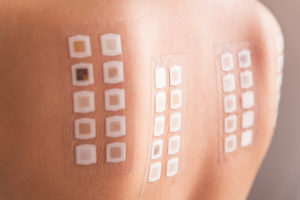Skin Testing vs Patch Testing: Which is Better to Detect Allergies?

If you believe that you have allergies then there are several tests that may work for you. When you work with Allergy, Asthma, and Immunology Medical Group, you can count on us providing comprehensive information on all the options available to you. Today we will cover skin testing and patch testing. Which is best? What do they entail? Keep reading to get answers and then contact us at 805-658-9500 to set up an appointment.
The facts about skin testing
When we use our skin allergy testing procedure, we are looking for foods, insects, and airborne allergens that you may be allergic to. We do this by measuring your allergic antibodies to these allergens. To begin with, we use a small plastic device that puts teeny amounts of solutions on your skin. This is done with either a prick or a scratch. This solution has various types of allergens and we will look for raised areas of the skin to show a positive reaction.
Keep in mind that there are other factors that come into play here, so just because there is an area of raised skin does not mean that you are allergic to the substance. If we do not see results from the first test then we can repeat with a very small needle that injects tiny amounts of the allergen into the first layer of your skin. This forms a small bubble, not unlike a mosquito bite.
In most cases, a skin test takes about 15 to 20 minutes to work. The area may itch but this will not last long. In order to get accurate results, we recommend avoiding antihistamines for at least five days but preferably seven days before you get tested. If you have hives or severe eczema, then this test will not be the right choice for you.
The facts about patch testing
When we use patch testing, we are checking for chemicals that cause a more delayed reaction. For example, contact dermatitis. This test involves a safe, chemical patch being placed on your back. To make sure it works correctly, make sure that the skin is clean and that you have showered recently. Do not use rubbing alcohol when cleaning or the patch will not stick correctly. In the event the patch peels off, the process will have to be started over from scratch.
The patch is left on for two days and then we remove it and examine it. We then wait three or four more days to ensure that nothing more has developed. If you are positive for the allergens tested, then you will have bumps, blisters, or swelling. This test does allow you to use antihistamines before and during testing, but topical creams are not allowed.
When you contact Allergy, Asthma, and Immunology Medical Group for your allergy testing, we will go over both options with you and let you know which one we recommend. We will then give you full instructions on what you can and can’t do in the days, weeks, and even month leading up to the test.



